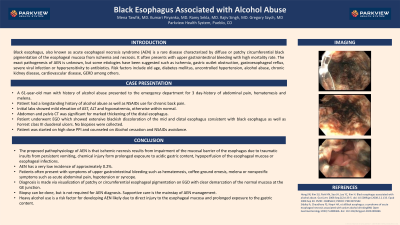Tuesday Poster Session
Category: Esophagus
P3324 - Black Esophagus Associated with Alcohol Abuse
Tuesday, October 24, 2023
10:30 AM - 4:00 PM PT
Location: Exhibit Hall

Has Audio

Mena Tawfik, MD
Parkview Medical Center
Pueblo, CO
Presenting Author(s)
Mena Tawfik, MD, Kumari Piryanka, MD, Ramy Sekla, MD, Rajiv Singh, MD, Gregory Szych, DO
Parkview Medical Center, Pueblo, CO
Introduction: Black esophagus, also known as acute esophageal necrosis syndrome (AEN) is a rare disease characterized by diffuse or patchy circumferential black pigmentation of the esophageal mucosa from ischemia and necrosis. It often presents with upper gastrointestinal bleeding and has high mortality rate. The exact pathogenesis of AEN is unknown, but some etiologies were suggested such as ischemia, gastric outlet obstruction, gastroesophageal reflux, severe viral infection or hypersensitivity to antibiotics. Risk factors include old age, diabetes mellitus, uncontrolled hypertension, alcohol abuse, chronic kidney disease, cardiovascular disease, GERD among others. We describe a case of black esophagus in a middle-aged male with chronic alcohol abuse.
Case Description/Methods: A 61-year-old man presented to the emergency department with abdominal pain, hematemesis and melena for 3 days. Patient reported greater than 750 mL of alcohol intake per day as well as daily NSAIDs use for chronic back pain. On admission, patient was hemodynamically stable. Initial workup showed mild elevation of AST, ALT and hyponatremia. Abdomen and pelvis CT was significant for marked thickening of the distal esophagus. On the following day, patient underwent EGD which showed extensive blackish discoloration of the distal esophagus consistent with black esophagus as well as Forrest class III duodenal ulcers. No biopsies were collected. Patient was started on high dose PPI and counseled on Alcohol cessation and NSAIDs avoidance. He was scheduled for an outpatient EGD in 8 weeks.
Discussion: AEN was first described in 1990 by Goldenberg et al. It occurs from ischemic injury to the esophageal mucosa likely due to impairment of the mucosal barrier due to traumatic insults from persistent vomiting, prolonged exposure to acidic gastric content, hypoperfusion of the mucosa or infections. Heavy alcohol use is a risk factor for developing AEN likely due to direct injury to the esophageal mucosa. AEN has a very low incidence of approximately 0.2%. Patients often present with symptoms of upper gastrointestinal bleeding or nonspecific symptoms such as abdominal pain, hypotension or syncope. Diagnosis is made via visualization of patchy or circumferential esophageal pigmentation on EGD with clear demarcation of the normal mucosa at the GEJ. Biopsy can be done, but is not required for diagnosis. Supportive care is the mainstay of management.

Disclosures:
Mena Tawfik, MD, Kumari Piryanka, MD, Ramy Sekla, MD, Rajiv Singh, MD, Gregory Szych, DO. P3324 - Black Esophagus Associated with Alcohol Abuse, ACG 2023 Annual Scientific Meeting Abstracts. Vancouver, BC, Canada: American College of Gastroenterology.
Parkview Medical Center, Pueblo, CO
Introduction: Black esophagus, also known as acute esophageal necrosis syndrome (AEN) is a rare disease characterized by diffuse or patchy circumferential black pigmentation of the esophageal mucosa from ischemia and necrosis. It often presents with upper gastrointestinal bleeding and has high mortality rate. The exact pathogenesis of AEN is unknown, but some etiologies were suggested such as ischemia, gastric outlet obstruction, gastroesophageal reflux, severe viral infection or hypersensitivity to antibiotics. Risk factors include old age, diabetes mellitus, uncontrolled hypertension, alcohol abuse, chronic kidney disease, cardiovascular disease, GERD among others. We describe a case of black esophagus in a middle-aged male with chronic alcohol abuse.
Case Description/Methods: A 61-year-old man presented to the emergency department with abdominal pain, hematemesis and melena for 3 days. Patient reported greater than 750 mL of alcohol intake per day as well as daily NSAIDs use for chronic back pain. On admission, patient was hemodynamically stable. Initial workup showed mild elevation of AST, ALT and hyponatremia. Abdomen and pelvis CT was significant for marked thickening of the distal esophagus. On the following day, patient underwent EGD which showed extensive blackish discoloration of the distal esophagus consistent with black esophagus as well as Forrest class III duodenal ulcers. No biopsies were collected. Patient was started on high dose PPI and counseled on Alcohol cessation and NSAIDs avoidance. He was scheduled for an outpatient EGD in 8 weeks.
Discussion: AEN was first described in 1990 by Goldenberg et al. It occurs from ischemic injury to the esophageal mucosa likely due to impairment of the mucosal barrier due to traumatic insults from persistent vomiting, prolonged exposure to acidic gastric content, hypoperfusion of the mucosa or infections. Heavy alcohol use is a risk factor for developing AEN likely due to direct injury to the esophageal mucosa. AEN has a very low incidence of approximately 0.2%. Patients often present with symptoms of upper gastrointestinal bleeding or nonspecific symptoms such as abdominal pain, hypotension or syncope. Diagnosis is made via visualization of patchy or circumferential esophageal pigmentation on EGD with clear demarcation of the normal mucosa at the GEJ. Biopsy can be done, but is not required for diagnosis. Supportive care is the mainstay of management.

Figure: Blackish discoloration of the middle and distal esophagus up to the GE junction consistent with black esophagus
Disclosures:
Mena Tawfik indicated no relevant financial relationships.
Kumari Piryanka indicated no relevant financial relationships.
Ramy Sekla indicated no relevant financial relationships.
Rajiv Singh indicated no relevant financial relationships.
Gregory Szych indicated no relevant financial relationships.
Mena Tawfik, MD, Kumari Piryanka, MD, Ramy Sekla, MD, Rajiv Singh, MD, Gregory Szych, DO. P3324 - Black Esophagus Associated with Alcohol Abuse, ACG 2023 Annual Scientific Meeting Abstracts. Vancouver, BC, Canada: American College of Gastroenterology.
